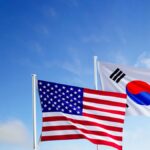Table of Contents
As Australia prepares for its federal election on May 3, 2025, the stakes couldn’t be higher. With the Australian Labor Party (ALP) currently in power under Prime Minister Anthony Albanese, voters are poised to decide the future direction of the nation. This election comes after a turbulent period marked by rising cost-of-living concerns, an increasingly uncertain global political climate, and domestic dissatisfaction with both major parties. The outcome will shape Australia’s economic policies, defense spending priorities, and its complex relationships with global powers like the United States and China.

A Closer Look at the Australian Election Landscape
Australia’s political system requires a party or coalition to win a majority in the House of Representatives to form a government. Currently, the Labor Party holds 77 seats, the Liberals 53, and 19 seats are held by minor parties and independents. In the 2022 election, Labor’s victory marked the end of a decade-long dominance by the Coalition (a partnership between the Liberals and Nationals). However, since then, Labor’s support has waned following a loss in the national referendum on Aboriginal rights in October 2023. Polls suggest a tight race ahead of the 2025 election, with Labor struggling to secure a majority but hoping to form a coalition government with the Greens and independent members, particularly the Teals—centrists focused on environmental issues.
Key Issues Shaping Voters’ Priorities
The upcoming election revolves around several key issues, with cost-of-living concerns at the forefront. Inflation, housing affordability, energy costs, and healthcare have all become significant factors in voters’ decisions. Neither Anthony Albanese (Labor) nor Peter Dutton (Liberal) is particularly popular, and both are attempting to use the election as a referendum on each other’s leadership abilities.
Social cohesion has also become a growing issue in Australia, especially following a rise in antisemitism. Attacks on Jewish citizens and vandalism have sparked national debates about social unity. While foreign policy issues have taken a back seat during this election cycle, recent provocations by China and the U.S.’s imposition of tariffs have pushed international relations into the spotlight.

The Election and Australia’s Foreign Policy
Traditionally, foreign policy doesn’t dominate Australian elections, but in 2025, it plays a supporting role. Both Labor and the Liberal opposition have framed the election as one about leadership on national security, economic stability, and defense. The rise of China’s assertiveness in the Indo-Pacific and the ongoing challenges in Australia’s relationship with the United States, especially under President Donald Trump, add complexity to the situation.
Australia’s relationship with the U.S. is at a crossroads. Despite the enduring security alliance, there are concerns about Trump’s transactional approach to foreign relations, especially with Australia’s recent experience with U.S. tariffs. The election will decide how Australia positions itself between these two global powers—whether to deepen ties with the U.S. or recalibrate its approach in response to China’s growing influence in the region.
How the Major Parties Are Differentiating Themselves
The election’s outcome will likely hinge on how well each party presents its approach to national security and defense. Labor has argued that it is the more diplomatic and nuanced party when it comes to dealing with China, while also pushing for an ambitious renewable energy agenda. In contrast, the Liberals argue that they are more realistic about the Chinese threat and advocate for increased defense spending.
Labor has committed to raising defense investment to 2.3% of GDP within ten years, a position that it claims will strengthen Australia’s security without compromising economic stability. Meanwhile, the Liberals are advocating for even higher defense spending—up to 2.5% of GDP by 2029—reflecting their belief that the current security environment demands stronger military readiness. However, polling shows that a significant portion of the Australian population is wary of increasing defense budgets, with only a third supporting higher spending.
Both parties are also keen to differentiate themselves in terms of their response to international crises. The looming shadow of the Trump administration’s unpredictability has cast a long one, and both Albanese and Dutton are grappling with how best to navigate this issue. Will Australia continue to support the U.S. in a manner that aligns with its strategic interests, or will it seek greater independence as the U.S. shifts its focus away from traditional allies?

Geopolitical Stakes: The U.S. and China in the Balance
The foreign policy implications of this election are profound. With Australia’s strategic position in the Indo-Pacific, its relationship with both the U.S. and China will shape the future of regional security and Australia’s economic trajectory. The ongoing instability in the South China Sea, China’s growing assertiveness, and the shifting global power balance all contribute to Australia’s need to reassess its alliances and foreign policies.
Australia’s relationship with the U.S., historically one of mutual security and economic cooperation, has been strained by the unpredictability of Trump’s policies, particularly regarding tariffs and trade. However, Australia’s defense partnership with the U.S. remains a pillar of the country’s foreign policy. At the same time, China’s increased influence in the region makes it crucial for Australia to balance its economic interests with national security concerns.
Australia has increasingly looked to strengthen its ties with other regional players, including Japan, South Korea, and Southeast Asian nations, in order to counterbalance China’s influence. How the new government navigates these relationships will play a pivotal role in the country’s geopolitical future.

Conclusion: What’s Next for Australia?
As Australia heads into one of the most significant elections in recent memory, the country faces a pivotal decision about its domestic future and its role on the global stage. The outcome of this election will determine not just who leads Australia but how it responds to the growing challenges of economic instability, defense needs, and international relationships. With the U.S. and China both playing crucial roles in the region, Australia’s foreign policy will be tested, and its position as a key player in the Indo-Pacific will continue to evolve.
The 2025 election is more than a domestic referendum; it’s a test of Australia’s ability to chart a clear path forward in an increasingly turbulent world. The choices made on May 3rd will shape the nation’s political, economic, and security policies for years to come.
Author Profile
- Syed Tahir Abbas is a Master's student at Southwest University, Chongqing, specializing in international relations and sustainable development. His research focuses on U.S.-China diplomacy, global geopolitics, and the role of education in shaping international policies. Syed has contributed to academic discussions on political dynamics, economic growth, and sustainable energy, aiming to offer fresh insights into global affairs.
Latest entries
 GeopoliticsAugust 23, 2025Previewing the White House Visit of South Korean President Lee Jae Myung
GeopoliticsAugust 23, 2025Previewing the White House Visit of South Korean President Lee Jae Myung Middle East ConflictJuly 22, 2025Israel’s Deadly Attacks on Gaza: A Dire Humanitarian Crisis and International Calls for a Truce
Middle East ConflictJuly 22, 2025Israel’s Deadly Attacks on Gaza: A Dire Humanitarian Crisis and International Calls for a Truce Middle East & North AfricaJuly 20, 2025Israel Targets Damascus Amid Rising Tensions in Syria
Middle East & North AfricaJuly 20, 2025Israel Targets Damascus Amid Rising Tensions in Syria Middle East AffairsJuly 14, 2025An Open Letter from Gaza’s University Presidents: Resisting Scholasticide Through Education
Middle East AffairsJuly 14, 2025An Open Letter from Gaza’s University Presidents: Resisting Scholasticide Through Education


